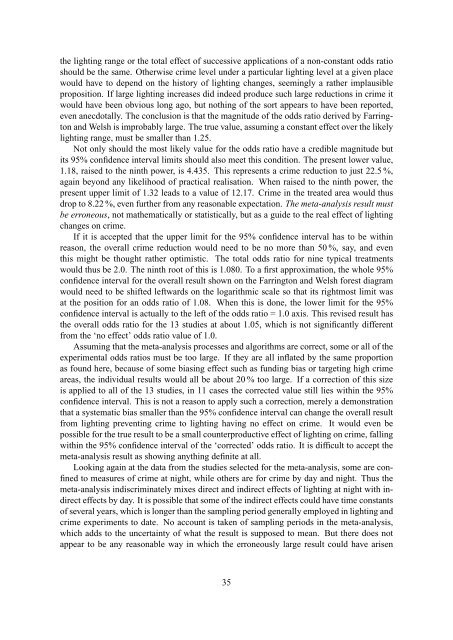outdoor lighting and crime, part 1 - Astronomical Society of Victoria
outdoor lighting and crime, part 1 - Astronomical Society of Victoria
outdoor lighting and crime, part 1 - Astronomical Society of Victoria
You also want an ePaper? Increase the reach of your titles
YUMPU automatically turns print PDFs into web optimized ePapers that Google loves.
the <strong>lighting</strong> range or the total effect <strong>of</strong> successive applications <strong>of</strong> a non-constant odds ratio<br />
should be the same. Otherwise <strong>crime</strong> level under a <strong>part</strong>icular <strong>lighting</strong> level at a given place<br />
would have to depend on the history <strong>of</strong> <strong>lighting</strong> changes, seemingly a rather implausible<br />
proposition. If large <strong>lighting</strong> increases did indeed produce such large reductions in <strong>crime</strong> it<br />
would have been obvious long ago, but nothing <strong>of</strong> the sort appears to have been reported,<br />
even anecdotally. The conclusion is that the magnitude <strong>of</strong> the odds ratio derived by Farrington<br />
<strong>and</strong> Welsh is improbably large. The true value, assuming a constant effect over the likely<br />
<strong>lighting</strong> range, must be smaller than 1.25.<br />
Not only should the most likely value for the odds ratio have a credible magnitude but<br />
its 95% confidence interval limits should also meet this condition. The present lower value,<br />
1.18, raised to the ninth power, is 4.435. This represents a <strong>crime</strong> reduction to just 22.5 %,<br />
again beyond any likelihood <strong>of</strong> practical realisation. When raised to the ninth power, the<br />
present upper limit <strong>of</strong> 1.32 leads to a value <strong>of</strong> 12.17. Crime in the treated area would thus<br />
drop to 8.22 %, even further from any reasonable expectation. The meta-analysis result must<br />
be erroneous, not mathematically or statistically, but as a guide to the real effect <strong>of</strong> <strong>lighting</strong><br />
changes on <strong>crime</strong>.<br />
If it is accepted that the upper limit for the 95% confidence interval has to be within<br />
reason, the overall <strong>crime</strong> reduction would need to be no more than 50 %, say, <strong>and</strong> even<br />
this might be thought rather optimistic. The total odds ratio for nine typical treatments<br />
would thus be 2.0. The ninth root <strong>of</strong> this is 1.080. To a first approximation, the whole 95%<br />
confidence interval for the overall result shown on the Farrington <strong>and</strong> Welsh forest diagram<br />
would need to be shifted leftwards on the logarithmic scale so that its rightmost limit was<br />
at the position for an odds ratio <strong>of</strong> 1.08. When this is done, the lower limit for the 95%<br />
confidence interval is actually to the left <strong>of</strong> the odds ratio = 1.0 axis. This revised result has<br />
the overall odds ratio for the 13 studies at about 1.05, which is not significantly different<br />
from the ‘no effect’ odds ratio value <strong>of</strong> 1.0.<br />
Assuming that the meta-analysis processes <strong>and</strong> algorithms are correct, some or all <strong>of</strong> the<br />
experimental odds ratios must be too large. If they are all inflated by the same proportion<br />
as found here, because <strong>of</strong> some biasing effect such as funding bias or targeting high <strong>crime</strong><br />
areas, the individual results would all be about 20 % too large. If a correction <strong>of</strong> this size<br />
is applied to all <strong>of</strong> the 13 studies, in 11 cases the corrected value still lies within the 95%<br />
confidence interval. This is not a reason to apply such a correction, merely a demonstration<br />
that a systematic bias smaller than the 95% confidence interval can change the overall result<br />
from <strong>lighting</strong> preventing <strong>crime</strong> to <strong>lighting</strong> having no effect on <strong>crime</strong>. It would even be<br />
possible for the true result to be a small counterproductive effect <strong>of</strong> <strong>lighting</strong> on <strong>crime</strong>, falling<br />
within the 95% confidence interval <strong>of</strong> the ‘corrected’ odds ratio. It is difficult to accept the<br />
meta-analysis result as showing anything definite at all.<br />
Looking again at the data from the studies selected for the meta-analysis, some are confined<br />
to measures <strong>of</strong> <strong>crime</strong> at night, while others are for <strong>crime</strong> by day <strong>and</strong> night. Thus the<br />
meta-analysis indiscriminately mixes direct <strong>and</strong> indirect effects <strong>of</strong> <strong>lighting</strong> at night with indirect<br />
effects by day. It is possible that some <strong>of</strong> the indirect effects could have time constants<br />
<strong>of</strong> several years, which is longer than the sampling period generally employed in <strong>lighting</strong> <strong>and</strong><br />
<strong>crime</strong> experiments to date. No account is taken <strong>of</strong> sampling periods in the meta-analysis,<br />
which adds to the uncertainty <strong>of</strong> what the result is supposed to mean. But there does not<br />
appear to be any reasonable way in which the erroneously large result could have arisen<br />
35
















